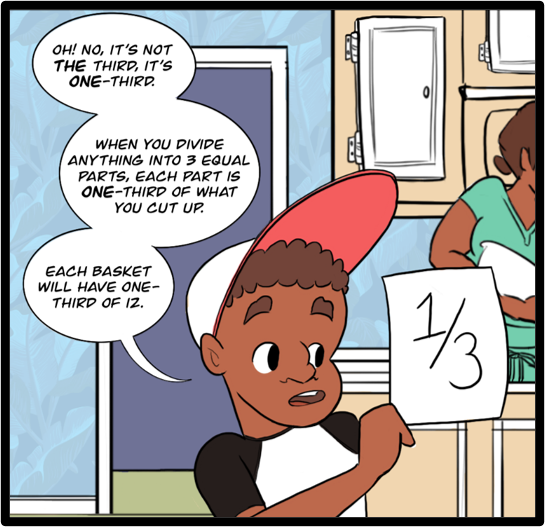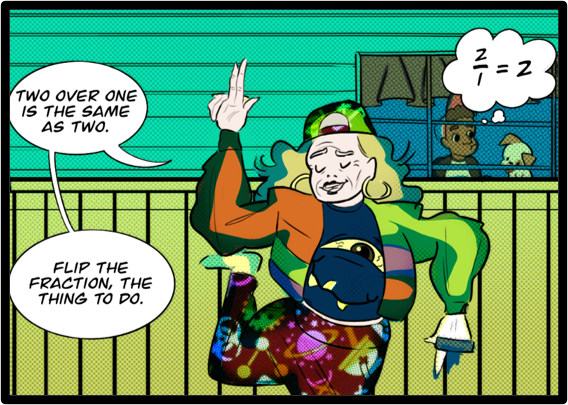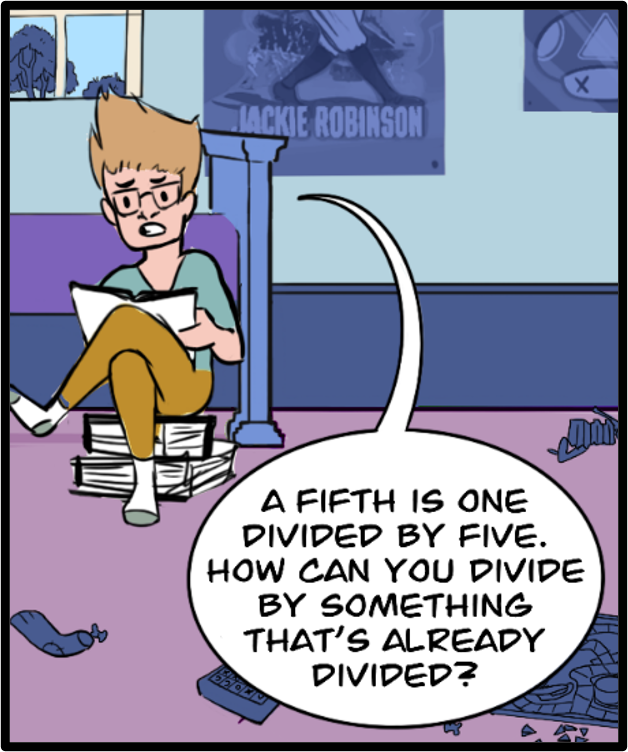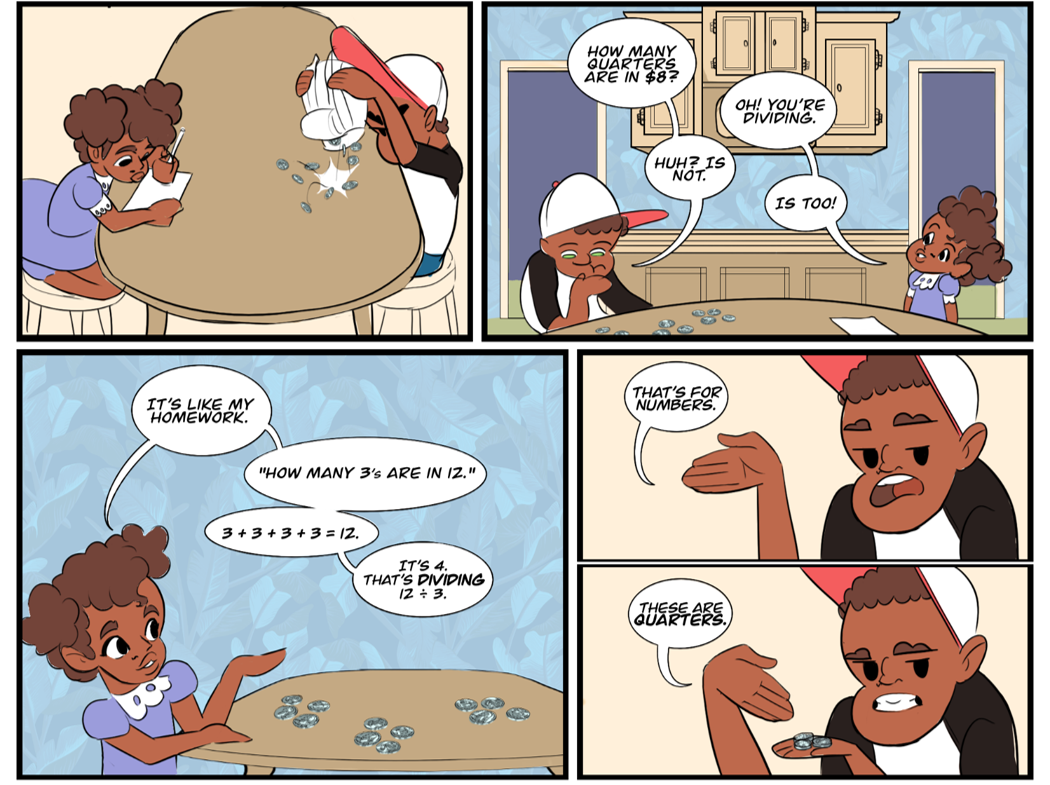I recently summarized research on how children think about fractions and described five different fraction concepts. One of my followers asked me if I put any of them in my comic book, and the answer is, "Yes!" The math comic books create opportunities for students to think about fractions - and teachers can help students explore different ways of thinking about fractions by using just few key questions.

Fractions as Part-Whole Relationship
When Theo explains what a fraction is to Leah in the first issue of The Mysterious I. D. Vide in Newton's Nemesis, he used the part-whole concept of fractions. He was also careful enough to explain that the whole needed to be cut into equal parts, which is a critical part of the definition. In his example, twelve is the whole.
Key Questions: Will Theo's definition work for all fractions? How would you define a fraction? Did you see fractions explained anywhere else in the story?
If we limit our definition to Theo's, children may think fractions are always smaller than the whole, which leaves out all improper fractions (i.e. fractions greater than one). But fractions can be difficult to define and the second question assesses what children already do and assumptions they may make. The final question sends the reader on a treasure hunt through the pages of the comic book to discover another way we think about fractions.
Fractions as Quotient
But earlier in the same issue, I subtly snuck in a couple of concepts during the comical scene of Ms. I. D. Vide trying to rap about fractions. When you think of a fraction as a little division problem (e.g. 3/4 is three divided by four) or the result of a division problem, you are thinking of the fraction as a quotient. Theo is thinking, "Two divided by one equals two," while Ms. Vide flippantly uses the word "over" in her rap.**
Key Questions: Is 2 divided by 1 really a fraction? If we think of parts and whole, what does the numerator of a fraction really mean? What does the denominator really mean?
Children may answer "no" to the first question, which ushers in a great conversation about the true meaning of numerators and denominators. Since the denominator is how many equal parts a whole is divided into, we need to divide 1 into 1 part; the numerator tells us to count or enumerate two wholes. Another extension: "Have you ever noticed that any number divided by one is it the number itself?" One is a special number in multiplication and division called an "identity". Why does that name make sense?
Such a simple scene can generate very interesting math discussions! However, thinking of a fraction as quotient also has its limitations, as Ben finds out in the second issue. He doesn't understand that a fraction is also a number that can be divided.
**A quick note ~ Math educators usually avoid using "over" when speaking about a fraction, but there were too many syllables in divide for the rap! So, I guess that is my "artistic license" ~ and don't you love how the word flippantly is so perfect for this situation!!!



Fraction as Operator
During the rapping scene, Ms. I. D. Vide also introduces fraction as an operator. Think about how common it is for us to say that we are taking a fraction of something. When we do, we are using the fraction to transform another number, and it acts like a function or operator. One math site explains, "A fraction can be seen as a division waiting to happen."
Key Question: When you take 1/4 of a number, what happens to that number?
We can use our part-whole conceptualization of fraction to rationalize that taking one-fourth of something results in a smaller number
Sometimes, researchers refer to the operation of a fractions as shrinking (when they are between zero and one) or stretching functions (when fractions are greater than one). The shrinking caused by fraction multiplication is the first time children encounter multiplication resulting in something smaller! So it is important to explore what happens with concrete examples: What is 1/4 of 12? What about 11/12's of 12? How about 13/12's of 12? Finally exploring 24/12's of 12 will reconnect with the previous panel in the comic book. Shrinking and stretching allows us to think of operators (i.e. addition, subtraction, multiplication, division) as transformers. For example 2 times 12 is taking 2 groups of 12, transforming 12 to 24. But this that leads to the next key question:
Key Question: When you take 1/4 of a group of 12, what operation are you performing?
Some children will say the operation is division, which feels right. When you ask them to explain, they usually discover that they are thinking, "12 divided by 4." Remind children that the key question asks about groups. If 2 groups of 12 is multiplication, what do you suppose 1/4 group of 12 is? Of course, this understanding brings us to a different conceptualization of 1/4. It is also a number or quantity, which leads to our next concept...
Fraction as Measurement or Magnitude
Like any number, fractions can be multiplied, divided, added or subtracted. In the second issue of my math comic book, Theo struggles to understand that a fraction is a number, just like any other number on a number line. This particular scene always make me chuckle, when he doesn't recognize that quarters are fractions!
In order for children to understand an expression such as 8 ÷ ¼, they need to know the ¼ represents a quantity, in other words a fraction is a number. That number has a magnitude, represents a distance from zero, and/or is a measurable distance between two other numbers.


Key Questions: Theo is thinking about 8 ÷ ¼ as how many quarters are in $8. Will that also work when 1/4 is a number on a number line? What other ways could we represent 8 ÷ ¼?
By asking children to explore different models such as using number lines, fraction strips, and pattern blocks, we are giving them multiple tools in their mathematical toolbox to solve problems.
Fraction as Ratio or Rate
Since ratios and rates typically are not introduced until middle grades, I did not have the characters explore this fraction meaning. However, there is an opportunity for teachers to use extension questions when two pizzas are delivered to our three heroes!
Extension Question: Theo's mother usually orders 3 pizzas for five people whenever his friends stay over. In the story, our three heroes ate 2 pizzas that were mysteriously delivered. Did they each get more, less, or the same pizza compared to the amount they usually get when Theo's mother orders?
Final Thoughts
Throughout the series, teachers and parents can use key questions to help their students connect the story with the mathematics and assess how they are thinking about fractions. As seasoned teachers know, you need to know what a child knows and understands before you can help them learn new ideas. Our job is to help them build a strong foundation of fraction understandings so they can explore what it means to multiply and divide by this new and incredibly useful set of numbers.
I hope this helps you use The Mysterious I. D. Vide in Newton's Nemesis to motivate great discussions about fractions!
